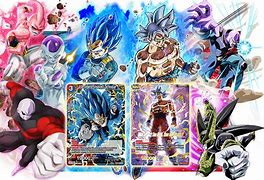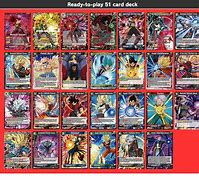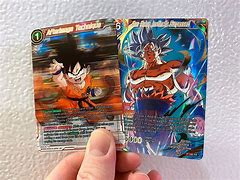Content Menu
● Understanding the Basics
>> Card Types
>> Leader Cards
>> Battle Cards
>> Extra Cards
>> Unison Cards
>> Z-Cards
● Setting Up the Game
● Gameplay Phases
>> Charge Phase
>> Main Phase
>> End Phase
● Combat Mechanics
>> Offense Step
>> Defense Step
>> Damage Step
● Awakening Your Leader Card
● Strategies for Success
● Advanced Gameplay Concepts
>> Card Synergy
>> Meta Awareness
>> Tournament Play
● Common Mistakes New Players Make
● Conclusion
● Frequently Asked Questions
>> 1. What is a Leader Card in Dragon Ball Card Game?
>> 2. How do I win a game of Dragon Ball Card Game?
>> 3. Can I attack on my first turn?
>> 4. What happens when my Leader card awakens?
>> 5. Are there any restrictions on how many cards I can have in my hand?
The Dragon Ball Super Card Game is an exciting trading card game that allows players to engage in intense battles using their favorite characters from the Dragon Ball universe. With its unique mechanics and strategic depth, it offers both casual and competitive players a thrilling experience. This guide will walk you through the essential rules, gameplay mechanics, and strategies to help you get started in the Dragon Ball Card Game.

Understanding the Basics
Before diving into the gameplay, it's crucial to understand the basic components of the game.
Card Types
There are several types of cards in the Dragon Ball Super Card Game:
Leader Cards
These represent your main character and are central to your strategy. Each player starts with one Leader card, which has two sides: the unawakened and awakened forms.
Battle Cards
These are the characters you deploy to fight against your opponent. Each Battle card has a power level and an energy cost.
Extra Cards
These provide various effects that can aid your strategy, such as drawing more cards or enhancing your Battle cards.
Unison Cards
These are additional allies that provide benefits during battles but are not required for beginners.
Z-Cards
Introduced in later sets, these cards add another layer of strategy but can be learned after mastering the basics.
Setting Up the Game
To begin playing, follow these steps:
1. Deck Preparation: Each player needs a deck consisting of 50 cards, including Leader cards, Battle cards, Extra cards, and optionally Unison and Z-cards.
2. Determine First Player: Players can use a random method (like rolling a die) to decide who goes first.
3. Draw Starting Hand: Each player draws six cards from their deck. Players may then discard any number of cards they don't want and draw new ones to replace them.
4. Life Area Setup: Each player takes the top eight cards from their deck and places them face down in their Life area. This represents their life total.
5. Energy Area Setup: The player going second places one energy marker in their Energy area.
6. Game Start: The first player begins their turn.
Gameplay Phases
Each turn consists of three main phases:
Charge Phase
- All Rest Mode cards are switched to Active Mode.
- The active player draws one card from their deck (the first player does not draw on their first turn).
- The player may place one card from their hand into their Energy area in Active Mode.
Main Phase
During this phase, players can perform various actions:
- Play Battle or Unison cards from their hand.
- Activate card skills.
- Awaken their Leader card if conditions are met.
- Engage in combat by declaring attacks against the opponent's Leader or Battle cards.
Players can perform these actions in any order and as many times as they want within this phase.
End Phase
In this phase, players resolve any end-of-turn effects before passing the turn to their opponent.
Combat Mechanics
Combat is a central aspect of the Dragon Ball Card Game and consists of three steps:
Offense Step
The attacking player declares which card is attacking and selects a target (either an opponent's Leader or a Rest Mode Battle card). They can boost their attack power by using combo cards or activating skills.
Defense Step
The defending player can respond by using combo cards or activating skills to enhance their defense against the attack.
Damage Step
Both players compare the total power levels (base power plus any bonuses from combos) to determine the outcome of the battle:
- If the attacker's power is greater than or equal to the defender's, damage is dealt.
- If attacking a Leader card, damage results in losing a Life card.
- If a Battle card is defeated, it is sent to the Drop area.
Awakening Your Leader Card
One unique feature of the Dragon Ball Super Card Game is the ability to awaken your Leader card. When certain conditions are met (usually involving taking damage), you flip your Leader card over to its awakened side, gaining increased power and new abilities. This mechanic reflects the transformation themes prevalent in Dragon Ball lore and adds excitement to gameplay.

Strategies for Success
To excel at the Dragon Ball Card Game, consider these strategies:
- Deck Building: Create a balanced deck that includes a mix of powerful Battle cards, useful Extra cards, and effective Leader abilities. Pay attention to energy costs and synergy between cards. A well-constructed deck can significantly enhance your chances of winning games.
- Resource Management: Manage your energy wisely; always consider whether to play more Battle cards or save energy for defensive plays during your opponent's turn. Understanding when to commit resources versus holding back for future turns is crucial for maintaining board presence and flexibility.
- Timing Your Attacks: Choose when to attack carefully; sometimes it's better to hold back and defend rather than risk losing key cards early on. An aggressive strategy can pay off but may leave you vulnerable if not executed properly.
- Combos and Skills: Make use of combos effectively during combat; combining multiple cards can turn the tide of battle in your favor. Understanding how different skills interact with each other will allow you to maximize damage output while minimizing losses.
Advanced Gameplay Concepts
As players become more familiar with basic mechanics, they can explore advanced concepts that enhance strategic depth:
Card Synergy
Building a deck with synergy means selecting cards that complement each other's strengths and weaknesses. For example, certain Battle cards may have abilities that trigger when specific Extra cards are played or when certain conditions are met during combat.
This synergy can create powerful combinations that can overwhelm opponents if executed correctly. Players should look for thematic connections within their decks based on character relationships from the anime or manga—such as Goku working well with other Saiyan characters—creating a narrative that enhances gameplay enjoyment.
Meta Awareness
Understanding the current meta—the most commonly played decks and strategies—can give players an edge in competitive play. Keeping track of popular builds allows players to adjust their decks accordingly, countering prevalent strategies while maintaining effectiveness against less common ones.
For instance, if many players utilize decks focused on aggressive strategies with low-cost Battle cards, building a defensive deck with high-power characters could provide an advantage by outlasting early aggression.
Tournament Play
For those interested in competitive play, participating in tournaments offers an opportunity to test skills against other dedicated players while striving for rewards such as exclusive promotional cards or recognition within local communities.
Tournament formats may vary—some may require specific deck construction rules (like limited card types) while others allow for more freedom—so it's essential to familiarize oneself with rules beforehand when preparing for events.
Common Mistakes New Players Make
New players often encounter challenges as they learn how to navigate gameplay effectively:
- Overcommitting Resources: Many beginners tend to play all available energy into attacking aggressively without considering potential counters from opponents' defenses or reactive plays later on turns.
- Ignoring Life Management: Focusing solely on defeating opponents while neglecting personal Life totals can lead quickly toward defeat; balancing offense with defense is key!
- Neglecting Combo Opportunities: Some players forget about utilizing combo opportunities during battles which could dramatically swing outcomes; practicing timing these plays will help improve overall performance over time!
Conclusion
The Dragon Ball Super Card Game combines strategy, excitement, and beloved characters from the franchise into an engaging tabletop experience. By understanding its mechanics—such as card types, phases of play, combat rules, and awakening—you'll be well on your way to mastering this dynamic game. Whether playing casually with friends or entering competitive tournaments, there's always something new to learn and explore within this vibrant universe.

Frequently Asked Questions
1. What is a Leader Card in Dragon Ball Card Game?
A Leader Card represents your main character during gameplay. It has two sides—unawakened and awakened—and is central to your strategy as it determines how you play throughout the game.
2. How do I win a game of Dragon Ball Card Game?
You win by reducing your opponent's Life total to zero by successfully attacking their Leader card or depleting their deck entirely so they cannot draw any more cards.
3. Can I attack on my first turn?
No, if you are the first player in a game of Dragon Ball Super Card Game, you cannot attack during your first turn; however, you can still perform other actions such as charging energy or playing Battle cards.
4. What happens when my Leader card awakens?
When your Leader card awakens, you flip it over to its awakened side, which typically provides increased power levels and new abilities that can significantly enhance your gameplay strategy.
5. Are there any restrictions on how many cards I can have in my hand?
There is no limit on how many cards you can hold in your hand during gameplay; however, managing your hand effectively is crucial for strategic play throughout each turn.































